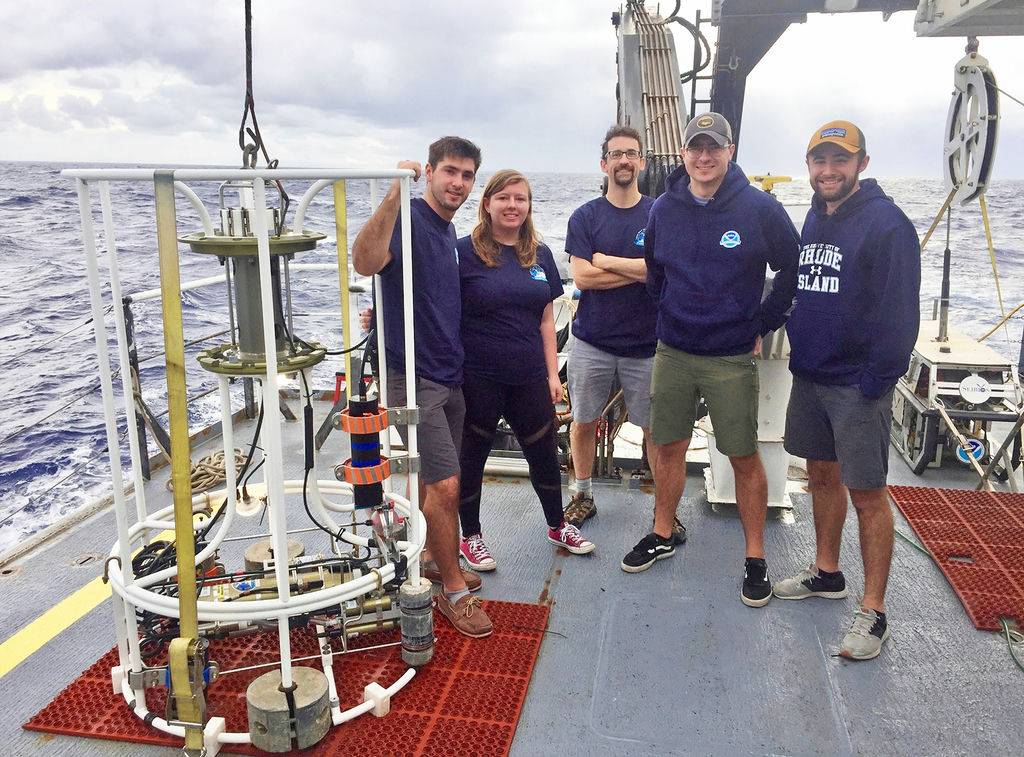
From left: Grady Bolan, Allison Redington, Associate Professor Stephen Licht, Sean Nagle and Josh Allder standing next to a CTD device on the deck of the Okeanos Explorer. Photo via Josh Allder/URI.
Four ocean engineering students from the University of Rhode Island (URI) have used a Form 2 SLA 3D printer to demonstrate the capabilities of 3D printing at sea.
Aboard a research vessel operated by the National Oceanic and Atmospheric Administration (NOAA), named the Okeanos Explorer, the team combatted the stormy seas to 3D print housing equipment for tools known as CTD’s (conductivity, temperature, and depth).
As oceanography instruments, CTD’s are used to measure the salinity (salt water level) and pressure of seawater.
3D printing through rough waves
The URI team recognized additive manufacturing as a solution for the timely replacement of equipment on research ships located in the middle of the ocean. However, the very same tumultuous conditions that damage and break such tools, must be addressed to properly 3D print new instruments.
Thus, the engineers examined previous motion data from the Okeanos Explorer and created a motion simulation platform for the Form 2 3D printer to simulate the movement of the ship and gauge how the machine would move onboard.
The Form 2 was also mounted on a stabilization platform, which, according to the URI is commonly used to stabilize IMAX cameras before setting sail from San Juan, Puerto Rico late last year.
“We came up with a test matrix to evaluate how well the printer can perform different tasks [and] that would allow us to quantitatively and qualitatively assess the mechanical properties of the results,” said Josh Allder, an Ocean Engineering student at URI.
Sea level additive manufacturing
Before departure, the team became familiar with the Form 2 and discovered the internal accelerometer, an integrated device which monitors the level of the machine throughout each 3D print.
If unstable, the resin in Form 2 can overflow or potentially spill which will negatively affect the 3D model’s outcome. Thus, an error message occurs and automatically pauses the print. URI’s motion simulation platform saved the students the trouble of manually level the 3D printer between each layer.
The students deliberately worked with an SLA 3D printer to produce denser, translucent parts of higher-resolution which cannot be created through FFF.
Testing on the waters
On open water, the URI team produced batch prints of three long bone-shaped pieces and a small cube. The bone-shaped pieces were then used for tensile testing. Following this, pressure housings were 3D printed to hold CTD instruments.
The structural integrity of the housings was tested as they were lowered into the sea at a depth of 200 meters. It was calculated that the units would hold their shape and seal as deep as 310 meters. Sean Nagle of the URI ocean engineering team explained:
“I was apprehensive while waiting for them to bring the housings back aboard the ship and into the lab. But I was ecstatic to see that both of the housings stayed watertight.”
“AS A PROOF OF CONCEPT, THIS WAS A GREAT SUCCESS. WE 3D PRINTED A PRESSURE HOUSING ON BOARD A MOVING RESEARCH VESSEL, USING A TYPE OF PRINTER THAT HAD NEVER BEEN BROUGHT TO SEA BEFORE.”
The URI team disembarked from the Okeanos Explorer in Nassau, the Bahamas, at the end of 2018. The findings of this research are recorded by the students in a 63-page document titled, “Stabilization System to Allow for 3D Printing in a Dynamic Environment.”
Source: 3dprintingindustry.com
Building on their established successes in India and the USA, EOS and Phillips Machine Tools…
CPAC, a subsidiary of SCG, has entered into a significant partnership with SAMSUNG E&A to…
A research team from Graz University of Technology (TU Graz) in Austria has introduced two…
Aircraft maintenance plays a critical role in today's aviation industry, especially given the current challenges…
Calum Stewart Calum Stewart, a leading figure at SPEE3D, has been at the forefront of…
The Vice President of Rolf Mack at KraussMaffei talks about the future vision of Additive…
This website uses cookies.